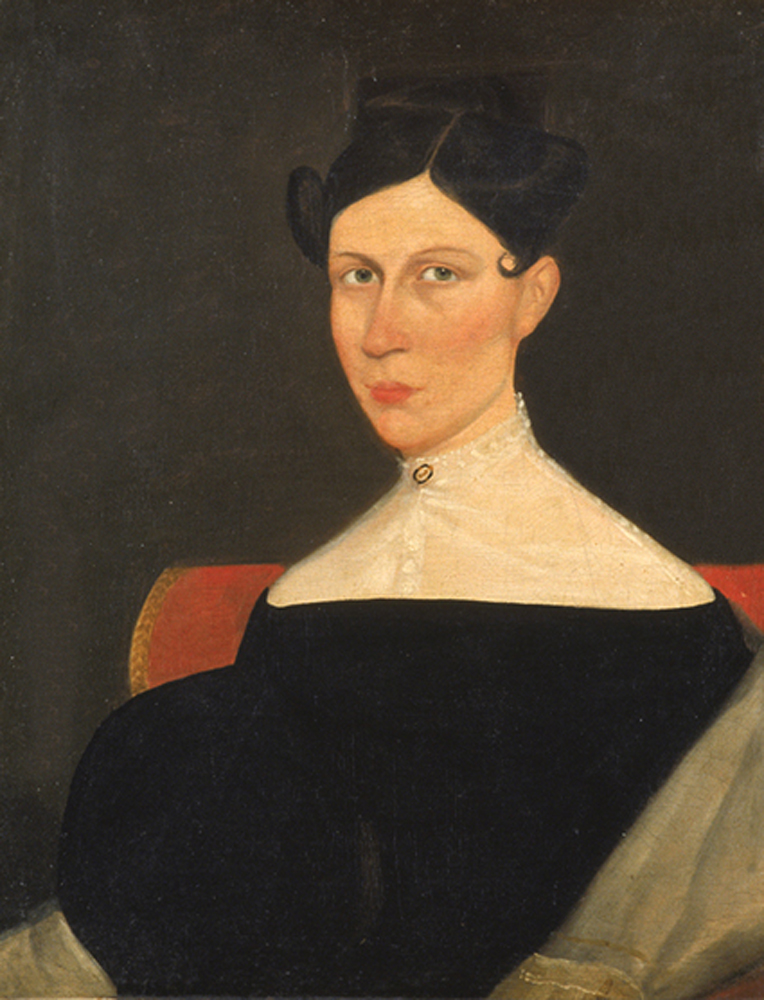
“Emily Merrill Bardwell,” attributed to Augustus Fuller. Oil on canvas, 29 by 23 inches, circa 1840. Courtesy Smith College Museum of Art.
BY SUZANNE AND MICHAEL PAYNE
CARMEL, N.Y. — We have been researching early American folk portrait painters of the first half of the Nineteenth Century for many years. Our eleventh article, describing Ira Chaffee Goodell, will be published shortly. We are currently examining the little-known deaf-mute painter Augustus Fuller (1812–73). Several of Fuller’s portraits were shown as part of a 1992 exhibition at Old Sturbridge Village, but there has never been an article written about him. The portraits of another deaf-mute American folk portrait painter, John Brewster Jr, have been much lauded for their artistry as well as for the insight they provide into the difficulties of a deaf-mute in America during the early 1800s. Augustus Fuller’s life represents a similar story of overcoming daunting challenges to be a professional artist.
Fortunately, the Fuller family of Deerfield, Mass., saved their letters, account books and documents. We have been able to examine and transcribe more than 50 letters written by Fuller himself. We have also examined hundreds of letters written by his parents and 12 siblings that mention him often. These primary documents allow us to present a remarkably personal view of Fuller’s life and career using quotes from his own letters.
Similar to John Brewster Jr, Fuller attended the American Asylum for the Education and Instruction of the Deaf and Dumb in Hartford, Conn. The experience immersed students in the revolutionary new French system of sign language as well the specialized teaching needed for the students to be able to read and write. The school also sought to provide students with a means to a livelihood. Fuller received art lessons when he attended the school between the ages of 12 and 16. After graduation, Fuller had several additional periods of art instruction, studying with Chester Harding in Boston, among others.
Fuller began his itinerant painting career around 1830. Because his worried parents were initially fearful that a deaf-mute would be taken advantage of, family members often accompanied him. In his newspaper advertisements, Fuller suggested that the local population would be interested in seeing how a deaf-mute artist had overcome his handicap. He invited the public to stop by his rented room to examine the portraits he could produce for them. During 1840, he traveled throughout upstate New York accompanied by his brother George. Upon seeing Augustus’s success as an artist, George decided to also become a painter. Many years later, George would be recognized as one of the most important American painters of the 1880s.
Augustus traveled alone as an itinerant portrait painter throughout New England and New York for several decades. His dealings with customers, boarding house owners, etc, resulted in many problems. Several of his letters express his loneliness as he traveled. Alcoholism appears to have often disrupted his life. Fuller was twice jailed for six months, once in 1850 for selling obscene pictures in Hamden, Conn., and later in Springfield, Mass., during 1857 for disorderly conduct. According to the letters between his siblings, his family appears to never have learned of the first prison sentence, while their accidental discovery of the second conviction caused much consternation and a demand that he stay on the family farm in Deerfield.
With the death of his father in 1859, Fuller increasingly left the farm searching for portrait commissions. During this period, Fuller also developed a new watercolor portrait style of an interior scene in a square format. Even during his last years, he still wrote of his dreams to go to Europe for further art study.
We are looking for additional signed examples of Fuller’s oil on canvas portraits, miniatures on ivory and small watercolor portraits to illustrate our article. If you know of such, please contact Michael and Suzanne Payne at mpayne@biodesignofny.com or PO Box 1050, Carmel NY 10512.
Read article and see more images inside June 26, 2015 E-edition

